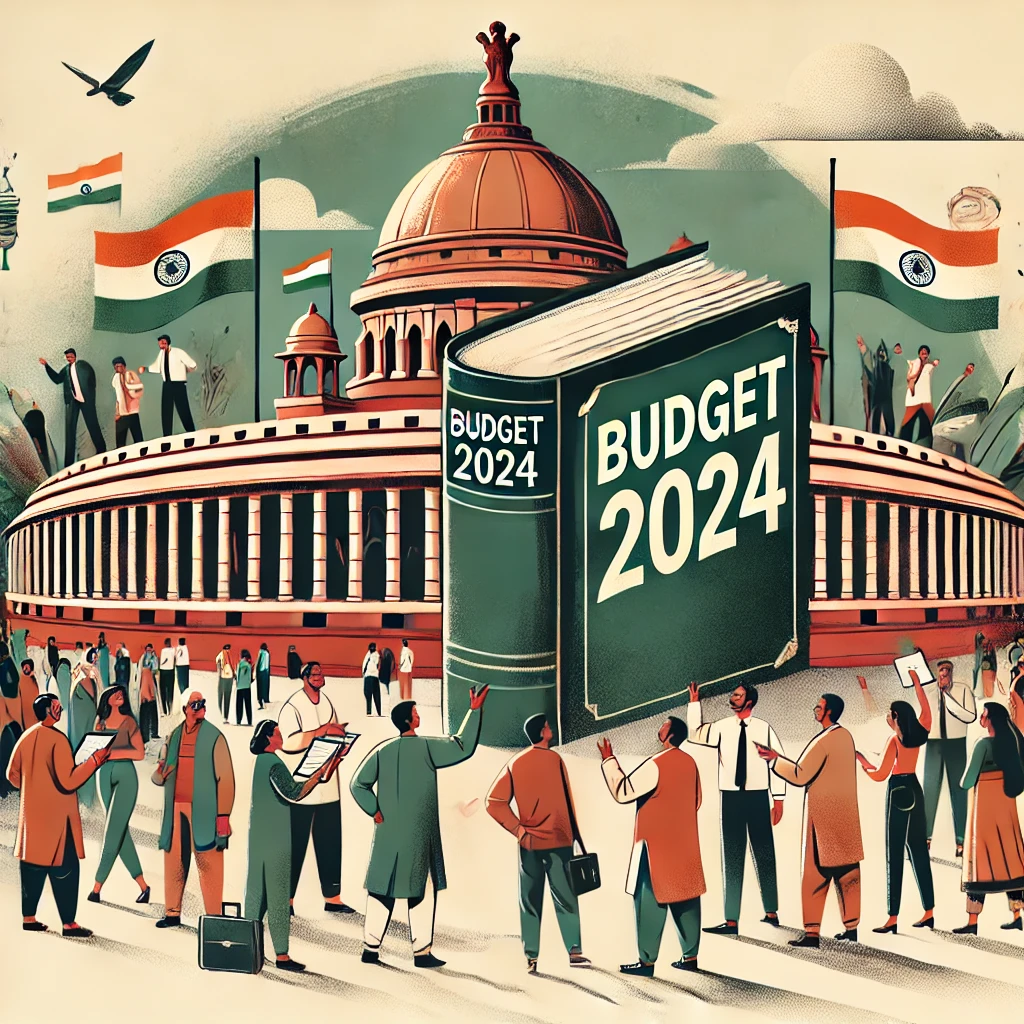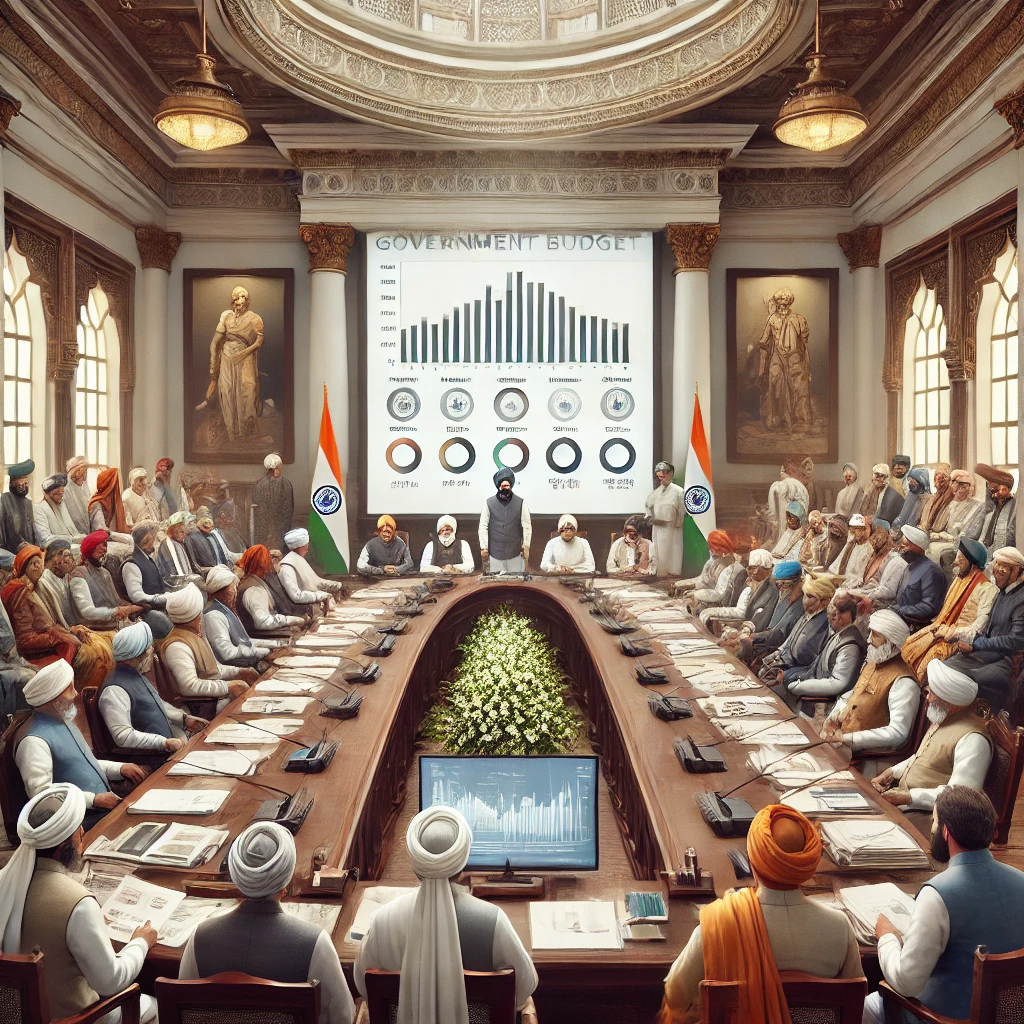A government budget is a detailed financial document that shows the anticipated revenues and proposed expenditures for a specific fiscal period, usually a year. It serves as a blueprint for the government’s economic policies. Government budgeting highlights how resources will be allocated to various sectors and development programs. The budget reflects the government’s priorities and is crucial for ensuring economic stability, growth, and social welfare.
Key features of the government budget include:
- Revenue Receipts: Includes taxes, fees, fines, and earnings from public enterprises.
- Capital Receipts: Comprises borrowings, loan recoveries, and proceeds from disinvestment.
- Revenue Expenditure: Covers day-to-day expenses, including salaries, subsidies, and welfare programs.
- Capital Expenditure: Involves spending on infrastructure, development projects, and asset creation.
Understanding the government budget is essential for citizens and policymakers alike, as it impacts every aspect of the economy and society. By analyzing the budget, one can gauge the government’s approach to addressing economic challenges, redistributing income, and fostering inclusive growth.

Components of the Government Budget
The government budget comprises the revenue budget and the capital budget. The revenue budget includes revenue receipts (tax and non-tax revenues) and revenue expenditure (operational costs). The capital budget encompasses capital receipts (borrowings, disinvestment) and capital expenditure (infrastructure and development projects).
Revenue Budget
The revenue budget is a critical component of the government budget, detailing revenue receipts and expenditures. It includes income from taxes, such as income tax, corporate tax, and goods and services tax (GST), as well as non-tax revenue like interest receipts, dividends, and fees. Revenue expenditure covers the government’s day-to-day operational costs, including salaries, subsidies, and social welfare programs. Unlike capital expenditure, which focuses on asset creation, revenue expenditure is used for immediate consumption and maintenance of existing services and infrastructure. The revenue budget helps manage the government’s recurrent expenditures and ensure fiscal stability.
Revenue Receipts
- Tax Revenue: Tax revenues are funds collected by the government from taxes, including income tax, corporate tax, goods and services tax (GST), customs duties, and excise duties, to finance public services and projects.
- Non-Tax Revenue: Non-tax revenues include income from interest, dividends, profits from public sector enterprises, fees, fines, and charges for government services, contributing to the government’s financial resources beyond taxation.
Revenue Expenditure
- Plan Expenditure: Plan expenditure refers to government spending on planned development projects and programs, aimed at fostering economic growth, infrastructure development, and social welfare, typically outlined in five-year plans.
- Non-Plan Expenditure: Non-plan expenditure includes routine government spending on defense, subsidies, interest payments, pensions, and administrative costs, focusing on the maintenance and operation of ongoing services and infrastructure.
Capital Budget
The capital budget is a crucial part of the government budget that deals with capital receipts and expenditures. It includes funds raised through borrowings, disinvestment, and recoveries of loans, used for creating long-term assets and infrastructure. Capital expenditure focuses on investments in projects like highways, schools, hospitals, and other public infrastructure, which enhance the nation’s productive capacity. Unlike revenue expenditure, which covers routine operational costs, capital expenditure leads to asset creation and long-term economic benefits. The capital budget helps stimulate economic growth, generate employment, and improve the overall standard of living by funding significant development projects.
Capital Receipts
- Borrowings and Other Liabilities: Borrowings and other liabilities refer to funds the government raises through loans from domestic and international sources to finance budget deficits and support capital expenditures.
- Recovery of Loans: Recovery of loans involves the repayment of funds previously lent by the government to states, public sector enterprises, or other entities, contributing to the government’s capital receipts.
- Disinvestment: Disinvestment refers to the government’s process of selling its equity stake in public sector enterprises, aimed at raising capital, reducing fiscal burden, and promoting private sector participation and efficiency.

Capital Expenditure
- Plan Capital Expenditure: Plan capital expenditure involves government spending on long-term development projects and infrastructure, such as roads, schools, and hospitals, aimed at fostering economic growth and enhancing public services.
- Non-Plan Capital Expenditure: Non-plan capital expenditure includes government spending on defense equipment, infrastructure maintenance, and loans to states and public enterprises, focusing on maintaining and upgrading existing assets and services.
Objectives of the Government Budget
The government budget aims to achieve multiple objectives that contribute to economic stability and growth. Key objectives include:
Economic Growth
The government budget promotes economic growth by allocating funds to various sectors, such as infrastructure, agriculture, industry, and services. Investment in these areas stimulates production, creates jobs, and enhances the overall economic output.
Redistribution of Income
Through progressive taxation and targeted welfare programs, the budget aims to reduce income inequality. It provides subsidies, social security, and welfare schemes to support the underprivileged sections of society.
Price Stability
The government budget helps control inflation and stabilize prices through monetary and fiscal measures. By regulating demand and supply through taxation and public expenditure, the government can influence the price levels in the economy.
Employment Generation
The budget allocates funds for employment generation schemes and skill development programs, which help reduce unemployment and underemployment. Programs like Mahatma Gandhi National Rural Employment Guarantee Act (MGNREGA) are examples of such initiatives.
Balanced Regional Development
The government budget promotes balanced regional development by allocating resources to underdeveloped and backward regions. Special grants and incentives are provided to promote industrial and infrastructure development in these areas.
Fiscal Discipline
The budget aims to maintain fiscal discipline by ensuring that the government’s expenditure does not exceed its revenue. It sets targets for fiscal deficit, revenue deficit, and primary deficit to ensure sustainable public finances.
Types of Government Budgets
Governments use different types of government budgets to address various economic scenarios and policy goals. The main types of budgets include:
Balanced Budget
A balanced budget occurs when a government’s total revenue equals its total expenditure. It indicates fiscal discipline and sustainability, as there is no deficit or surplus. This budget approach helps maintain economic stability and avoids increasing public debt.
Surplus Budget
A surplus budget occurs when a government’s total revenue exceeds its total expenditure. The surplus budget results in a budget surplus, allowing the government to reduce public debt, build reserves, and provide financial stability for future economic challenges.
Deficit Budget
A deficit budget happens when the government’s total expenditure exceeds its total revenue. This type of budget is used to stimulate economic growth during periods of recession or economic slowdown. The deficit is usually financed through borrowing.
Zero-Based Budget
In a zero-based budget, every department starts from a “zero base,” and every function within an organization is analyzed for its needs and costs. Budgets are then built around what is needed for the upcoming period, regardless of whether the budget is higher or lower than the previous one.
Performance Budget
A performance budget links government spending to outcomes and results, emphasizing efficiency and effectiveness. It assesses whether financial resources achieve desired goals and improve service delivery, focusing on achieving measurable results and maximizing value for public expenditure.
Gender Budget
A gender budget allocates funds specifically to address gender disparities and promote gender equality. It focuses on programs and schemes that benefit women and girls, ensuring that they have equal access to resources and opportunities.
Government Budgeting and the Economy
The government budget significantly impacts the economy by outlining revenue collection and expenditure plans. It guides resource allocation to various sectors, influencing economic growth, stability, and social welfare. By managing public funds through tax policies and spending programs, the budget addresses economic challenges, stimulates development, and promotes equitable distribution of wealth. Fiscal measures in the budget, such as deficit financing and public investment, play a crucial role in shaping economic trends and achieving long-term financial stability.
Government Budget of India
The government budget of India is an annual financial statement presented by the Finance Minister, outlining the country’s revenue and expenditure for the upcoming fiscal year. It includes allocations for various sectors like healthcare, education, infrastructure, and defense. The budget aims to drive economic growth, reduce poverty, and enhance social welfare. Key features include tax proposals, fiscal deficit targets, and investment plans. The Union Budget reflects the government’s economic policies and priorities, impacting India’s overall development and financial stability.
Conclusion of Government Budget
Understanding government budgeting is crucial for UPSC aspirants as it encompasses the government’s financial strategy, economic policies, and developmental priorities. It provides insights into revenue generation, resource allocation, and expenditure management, reflecting the government’s approach to addressing economic challenges and fostering growth. Analyzing the budget helps aspirants grasp the intricacies of fiscal policy, public finance, and socio-economic development. It is a vital tool for ensuring economic stability, reducing disparities, and promoting sustainable development. Mastery of budgetary concepts enables UPSC candidates to critically evaluate government policies and their impact on India’s economy and society.
Government Budgeting UPSC Handnotes

